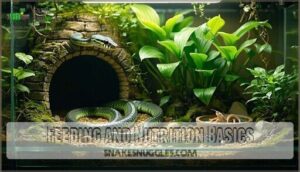This site is supported by our readers. We may earn a commission, at no cost to you, if you purchase through links.
 A snake care guide for beginners starts with three foundational elements: choosing a docile species like corn snakes or ball pythons, setting up a secure enclosure with proper temperature gradients (usually 75-85°F), and establishing a feeding routine with appropriately sized frozen-thawed prey.
A snake care guide for beginners starts with three foundational elements: choosing a docile species like corn snakes or ball pythons, setting up a secure enclosure with proper temperature gradients (usually 75-85°F), and establishing a feeding routine with appropriately sized frozen-thawed prey.
You won’t be tied to a daily routine—adult snakes only eat every 10-14 days and just need quick spot-cleaning between weekly maintenance.
Success hinges on understanding your snake’s baseline health indicators, recognizing normal shedding cycles, and maintaining consistent humidity levels between 40-60% depending on species. The real art lies in reading your snake’s behavior and adjusting care before problems emerge.
Table Of Contents
- Key Takeaways
- Choosing The Right Beginner Snake
- Setting Up a Safe Snake Habitat
- Feeding and Nutrition Basics
- Handling, Bonding, and Safety
- Monitoring Health and Shedding
- Frequently Asked Questions (FAQs)
- How to choose pet snakes for beginners?
- How do I choose a snake species?
- How to keep a pet snake?
- What do you need to prepare a snake?
- How to take care of a snake for beginners?
- What is the easiest snake to take care of for beginners?
- What to do when you first bring a snake home?
- What does a snake need in its cage?
- How long do pet snakes typically live?
- Can different snake species be housed together?
- Conclusion
Key Takeaways
- Choose beginner-friendly species like corn snakes or ball pythons that have docile temperaments, manageable adult sizes (4-6 feet), and straightforward care requirements—these species rarely bite when handled properly and tolerate handling mistakes better than defensive species.
- Create proper thermal gradients in your enclosure with a warm side at 85-90°F and a cool side at 75-80°F, using under-tank heaters or ceramic heat emitters controlled by thermostats—snakes can’t regulate their body temperature and need these zones for proper digestion and health.
- Feed frozen-thawed prey that matches your snake’s thickest body section every 10-14 days for adults (weekly for juveniles)—this eliminates bite risks from live prey while providing complete nutrition, and use feeding tongs to maintain a safe distance during feeding.
- Monitor shedding cycles and health indicators by watching for clear eyes, smooth scales, strong feeding response, and complete sheds—cloudy eyes signal incoming sheds requiring increased humidity to 60-70%, while persistent feeding refusal, respiratory symptoms, or incomplete sheds warrant veterinary consultation.
Choosing The Right Beginner Snake
Your first snake should match your experience level and living situation. Corn snakes, kingsnakes, and ball pythons are popular starter species because they’re docile, have manageable care requirements, and rarely bite when handled properly.
Popular Snake Species for Beginners
Why do so many beginners gravitate toward certain snake species? Corn snakes dominate the pet industry, accounting for the majority of beginner-level reptile ownership in the United States. These docile snakes offer over 100 color morphs, making them visually appealing while remaining affordable at around $69 for common varieties.
Ball pythons represent another excellent beginner option, featuring calm temperaments and remarkable genetic diversity with over 7,500 documented morphs driving current reptile trends. Many owners start with snakes that have specific care and feeding requirements.
Key Factors When Selecting a Snake
Your snake selection process should prioritize four critical factors that directly impact your success as a new reptile owner. Adult size matters more than you might think—that cute juvenile corn snake will reach 4-6 feet, while a baby Burmese python can grow beyond 18 feet and need a room-sized enclosure.
Temperament and handling ease deserve serious consideration too. Docile species like corn snakes rarely bite and tolerate handling well, while more defensive breeds might stress easily or react aggressively to interaction.
Habitat requirements can make or break your setup. Different species need vastly different enclosure sizes, temperature ranges, and humidity levels—what works for a ball python won’t suit a kingsnake.
Temperament and Handling Needs
Think of a snake’s personality like a fingerprint—each species comes with its own behavioral blueprint that’ll shape every interaction you have together. Understanding temperament tests and snake behavior helps you choose the right match for your handling comfort level.
| Species | Temperament | Handling Frequency | Defensive Behaviors | Beginner Rating |
|---|---|---|---|---|
| Corn Snake | Docile, calm | 2-3x weekly | Rarely defensive | Excellent |
| Ball Python | Shy, gentle | 1-2x weekly | Balls up when stressed | Very Good |
| King Snake | Active, confident | 2-3x weekly | May bite if startled | Good |
| California King | Bold, curious | 2-3x weekly | Occasional musking | Good |
| Kenyan Sand Boa | Calm, tolerant | 1-2x weekly | Rarely aggressive | Very Good |
Gentle taming through consistent, calm interactions builds trust with your pet snake, making handling sessions safer and more enjoyable for both of you.
Long-term Commitment and Lifespan
Before you welcome that scaly companion into your life, here’s something most new snake owners don’t realize: your pet could easily outlive your college years, your first job, and maybe even your mortgage. Snake longevity varies dramatically by species, with commitment levels spanning decades.
Here’s what you need to know about lifespan before picking your snake:
- Corn snakes live 15-20 years – perfect for long-term reptile health and wellness
- Ball pythons can reach 30+ years – requiring substantial age considerations
- Kingsnakes average 12-18 years – moderate snake care and maintenance commitment
- Smaller species like Kenyan sand boas live 15+ years – still significant pet ownership dedication
- Your snake’s environment directly impacts longevity – proper snake care guide adherence extends lifespan
That’s why choosing your species isn’t just about temperament—it’s about matching your life plans with your snake’s expected journey alongside you.
Cost Considerations for Ownership
Owning a snake might seem budget-friendly at first, but the real costs can surprise new pet parents who haven’t planned for the long haul. Initial costs include a proper enclosure, heating equipment, and substrate—easily $300-500.
Monthly costs pile up fast—you’re looking at food every few weeks, fresh bedding, and vet bills when health issues pop up.
Snake ownership isn’t just about the upfront cash; you need a solid budget for years of care ahead.
Setting Up a Safe Snake Habitat
Your snake’s habitat is their entire world, so getting the setup right from day one prevents stress and health problems down the road.
A proper enclosure with secure lids, temperature gradients, appropriate substrate, and essential hiding spots creates the foundation for your snake’s long-term well-being.
Enclosure Size and Security
Your snake’s enclosure isn’t just a home—it’s their entire world, and getting the size and security right can mean the difference between a thriving pet and a stressed escape artist.
Choose a terrarium design that’s at least twice your snake’s length with secure lids featuring proper ventilation systems. Quality enclosure materials and escape-proof locks prevent your reptile from becoming an unwanted house guest wandering your home.
Heating, Lighting, and Temperature Gradients
Three critical heating elements form your snake’s thermal foundation. Heat sources like ceramic heat emitters or under-tank heaters create essential temperature gradients—cool zones at 75-85°F and warm basking areas reaching 85-90°F.
A good thermostat acts as your safety net here, keeping temps steady and preventing those scary spikes that could hurt your snake.
UVB lighting aids vitamin D3 synthesis, with 12-hour lighting cycles mimicking natural day-night patterns for ideal health.
Substrate Options and Humidity Control
Think of substrate as your snake’s foundation—get it wrong, and you’re setting up a cascade of health problems that could have been easily prevented.
Aspen shavings and cypress mulch excel at moisture control while allowing natural burrowing behaviors.
Monitor humidity levels between 50-60% using a reliable hygrometer, adjusting substrate depth to maintain proper moisture gradients throughout your snake’s terrarium environment.
Essential Hides and Enrichment Items
Just like people need their own space to feel secure, your snake requires specific hiding spots and enrichment items to thrive both physically and mentally.
Provide at least two hides—one on the warm side, one cool—that fit snugly around your snake’s body. Add climbing structures like branches for arboreal species, and visual barriers to reduce stress in your terrarium setup.
Cleaning and Maintenance Routines
A clean snake habitat isn’t just about aesthetics—it’s the foundation of your pet’s health and your own peace of mind.
Spot-clean waste immediately and perform weekly water changes to maintain proper humidity control.
Monthly deep cleaning of your snake enclosure involves removing substrate, sanitizing surfaces with reptile-safe disinfectant, and replacing bedding completely for ideal snake health and wellness.
Feeding and Nutrition Basics
Understanding your snake’s dietary needs is essential for maintaining their health and preventing nutritional problems. Proper feeding involves selecting the right prey size, establishing appropriate feeding schedules, and using safe techniques that protect both you and your pet.
Appropriate Diet for Pet Snakes
Getting your snake’s nutrition right comes down to one key thing: whole prey animals give them everything they need. Dogs and cats benefit from variety in their meals, but snakes work differently. They’ve evolved to eat entire animals that naturally provide complete, balanced nutrition.
Unlike dogs and cats that need varied diets, snakes thrive on whole prey animals that naturally deliver complete, balanced nutrition
- Whole rodents deliver the perfect 2:1 calcium-to-phosphorus ratio your snake needs for strong bones and proper metabolism
- Frozen-thawed prey keeps your snake safe from disease while preserving all the nutritional value better than live feeding
- Most corn snakes do best with appropriately-sized mice since that matches what they’d hunt in the wild
- Switching between mice and rats prevents nutrient gaps and supports better long-term health
- Skip the supplements when feeding quality whole prey—adding extras can actually cause more harm than good
Feeding Frequency and Prey Size
Getting your snake’s meal schedule wrong is like trying to fuel a sports car with bicycle portions—it just won’t work. Young snakes need weekly feeding schedules, while adults can go 10-14 days between meals.
Prey selection should match your snake’s widest point—too large causes regurgitation, too small leaves them undernourished. Corn snake feeding follows these same principles for ideal nutrition.
Frozen-thawed Vs. Live Prey
The great prey debate in snake keeping isn’t just about convenience—it’s about safety for both you and your serpent companion. Frozen-thawed prey eliminates bite risks and parasite transmission while offering consistent nutrition.
Live feeding can trigger stronger feeding responses but poses injury risks. Most veterinarians recommend frozen-thawed options for safer reptile care and maintenance practices.
Safe Feeding Techniques
Feeding your snake isn’t just about dropping a mouse in the tank and walking away—proper technique can mean the difference between a successful meal and a stressed, injured animal.
Use feeding tongs to safely present prey, maintaining distance from your snake’s strike zone. Establish a consistent feeding schedule in a quiet location, allowing adequate food storage time for frozen-thawed prey to properly thaw before offering.
Troubleshooting Feeding Issues
Even the most experienced snake owners sometimes face the frustrating puzzle of a pet that simply won’t eat. Feeding refusal often stems from stress, incorrect prey size issues, or disrupted feeding schedules. Understanding your corn snake feeding and diet patterns helps identify whether digestive problems or environmental factors are affecting their snake care routine.
Common feeding solutions include:
- Check temperature gradients – Cold snakes won’t digest properly
- Verify prey size – Should match the thickest part of your snake’s body
- Reduce handling stress – Wait 48 hours after feeding attempts
- Adjust feeding schedule – Some snakes prefer evening meals
- Rule out illness – Persistent refusal warrants veterinary consultation
Handling, Bonding, and Safety
Learning proper handling techniques is essential for your safety and your snake’s well-being. Understanding when and how to interact with your new pet helps build trust while preventing stress-related health issues.
Safe Handling Techniques for Beginners
Learning to handle your snake properly isn’t just about avoiding a bite—it’s about building trust with an animal that relies entirely on body language to communicate its comfort level.
Start with a gentle touch behind the head, supporting the body’s weight. Snake hooks help beginners maintain a safe distance initially. Handling gloves provide confidence while learning proper grip.
Always secure enclosure lids for escape prevention—stress reduction keeps your pet snake calm during handling sessions.
Acclimation and Stress Reduction
Moving your new snake into its forever home isn’t like flipping a light switch—it’s more like helping a houseguest settle into unfamiliar territory where every sound, smell, and vibration feels foreign. Your snake needs time to adjust without the added stress of handling or environmental changes.
Here’s what your snake needs to settle in comfortably:
- Leave your snake undisturbed for 1-2 weeks in its terrarium to reduce relocation anxiety
- Maintain consistent temperature and humidity levels during this critical adjustment period
- Avoid rearranging habitat enrichment items or decorations until after successful acclimation
- Monitor feeding response as appetite often decreases temporarily during habitat optimization transitions
Understanding Snake Body Language
Snakes don’t wag their tails or purr when they’re happy, but they communicate volumes through subtle body movements that can keep you safe and stress-free during handling sessions.
A relaxed pet snake moves slowly with smooth, deliberate motions and maintains loose snake posture. Watch for defensive behavior like coiling tightly, forming an S-shape, or rapid tail vibrations—these signal stress. Avoid direct eye contact, which snakes interpret as threatening.
Normal scent marking through tongue-flicking shows curiosity, not aggression.
Hygiene and Disease Prevention
Keeping your snake healthy isn’t just about feeding and housing—it’s about creating a clean environment that protects both you and your scaly companion from potentially harmful bacteria and parasites.
Always wash your hands thoroughly before and after handling your snake or cleaning its enclosure. Use separate cleaning tools for your snake’s habitat to prevent cross-contamination with household items.
Regular sanitation practices help prevent snake mites and other infections that can compromise both reptile care and your family’s health.
Common Handling Mistakes
Most new snake owners handle their pets like they would a cat or dog, but snakes operate by completely different rules that can turn a simple interaction into a stressful ordeal for both of you.
Over handling is the biggest mistake—snakes need quiet time between sessions. Grabbing mid-body without proper backing causes panic, while handling too soon after feeding can trigger regurgitation.
Always bear their body weight and watch for defensive posturing.
Monitoring Health and Shedding
Keeping your snake healthy means watching for changes in behavior, appetite, and physical appearance that signal potential problems.
Regular monitoring during shedding cycles and knowing when to contact a reptile veterinarian can prevent minor issues from becoming serious health concerns.
Signs of a Healthy Snake
A healthy snake might seem like a mystery wrapped in scales, but once you know what to look for, their well-being becomes surprisingly easy to read. Pay attention to these indicators of good snake health:
- Clear, bright eyes without cloudiness (except during the shedding process)
- Healthy scales that lie flat, appearing smooth and free from lesions or discoloration
- Strong feeding response when prey is offered, indicating normal appetite and animal health
- Firm body condition with visible muscle tone—not too thin or obese
- Regular, complete sheds that come off in one piece, reflecting proper reptile care
These signs tell you your corn snake health and welfare are on track.
Common Health Problems and Prevention
Snake ownership comes with some common health challenges, but most are totally manageable with the right approach. About 5–10% of pet snakes develop respiratory problems—you’ll notice wheezing or mucus around their nose. Parasites are another biggie. Around 21% carry internal worms, and over 15% deal with mites at some point.
The fix? Regular vet checkups and keeping their habitat spotless. Food-wise, keep it simple but varied. Snakes on boring, repetitive diets run into nutritional problems about 23% of the time. Mix up their prey types and sizes.
Here’s the game-changer: proper temperature and humidity can slash health issues by 40–80%. It’s worth getting right. One thing people forget—56% of snakes carry Salmonella. Always wash your hands after handling. Your snake will be healthiest with clean living conditions, good food variety, and a vet who knows reptiles.
| Health Concern | Prevention Strategy |
|---|---|
| Respiratory infections | Maintain ideal temperature and humidity; quarantine new arrivals |
| Parasites (internal/external) | Regular health checks; habitat sanitation; quarantine protocols |
| Nutritional deficiencies | Offer varied, appropriate prey; avoid rancid or monotonous diets |
| Zoonotic disease transmission | Wash hands thoroughly; disinfect surfaces; routine veterinary visits |
Recognizing and Managing Shedding
If your snake’s eyes cloud over and it starts rubbing against rough surfaces, you’re witnessing one of nature’s most extraordinary processes—and your pet needs specific assistance to shed safely. The shedding process, or ecdysis, occurs in predictable shedding cycles as your snake grows.
What you need to do:
- Boost humidity control to 60-70% during the cloudy-eye phase to prevent skin issues and stuck shed
- Maintain your temperature gradient so your snake can thermoregulate properly throughout the cycle
- Check carefully post-shed for retained eye caps or tail tips, which can indicate mite infestations or improper environmental conditions
Understanding snake behavior and enrichment during shedding helps you provide appropriate snake care when your pet is most vulnerable.
When to Seek Veterinary Care
Even the healthiest snake can develop serious problems quickly, and knowing when professional help is needed isn’t always straightforward. Look for discharge from the eyes, nose, or mouth, runny droppings, or visible snake injuries. Schedule health exams with a reptile veterinary clinic annually—even without obvious health concerns. Emergency care becomes critical when you notice respiratory distress, prolonged lack of appetite, or unusual swelling. Medical treatments and veterinary care guarantee your snake’s health and wellness for years to come.
| Symptom Category | Warning Signs | Action Required |
|---|---|---|
| Respiratory | Wheezing, open-mouth breathing, mucus | Emergency care needed |
| Digestive | Regurgitation, bloody stool, bloating | Veterinary signs requiring prompt visit |
| Physical | Wounds, lumps, mouth rot, scale issues | Medical treatments within 24-48 hours |
| Behavioral | Lethargy, refusal to eat 3+ weeks | Health exams to diagnose cause |
| Routine | No visible problems | Annual snake care checkup recommended |
Environmental Enrichment for Well-being
Think of enrichment as the difference between a warehouse and a home—both provide shelter, but only one feels like a place worth living in. Your snake enclosure needs spatial complexity through varied habitat decor—branches for climbing, multiple hides, and textured surfaces.
Environmental stimulation matters: thermal gradients let your snake thermoregulate, while maintaining proper humidity encourages natural behaviors. Sensory enrichment through vivarium setup transforms a basic terrarium into a functional, engaging space that promotes well-being.
Frequently Asked Questions (FAQs)
How to choose pet snakes for beginners?
When selecting your first pet snake, prioritize beginner snake traits like docile temperament and straightforward handling techniques.
Conduct thorough pet store research to find healthy corn snakes or similar beginner-friendly exotic pets, consulting herpetology resources for snake breed selection and proper snake temperament assessment.
How do I choose a snake species?
When selecting from over 3,000 species in herpetology, prioritize breed characteristics like adult size, temperament, and snake diet requirements.
Corn snakes excel as exotic pets due to their docile nature and straightforward care.
Conduct thorough snake research comparing species for pet suitability based on your owner preferences.
How to keep a pet snake?
Keeping your pet snake healthy isn’t rocket science—it starts with understanding Snake Behavior and mastering the fundamentals of reptile care. Here’s what matters most:
- Design a proper Snake Habitat with temperature gradients and secure hiding spots
- Feed an appropriate Snake Diet of frozen-thawed prey on schedule
- Monitor Reptile and Snake Biology through regular health checks
- Connect with the Snake Owner Community for ongoing Reptile Care Tips
What do you need to prepare a snake?
Before bringing your snake home, you’ll need a proper vivarium setup and maintenance essentials. This includes a secure enclosure with heating sources for temperature regulation, appropriate substrate for bedding, humidity control equipment, and a care sheet specific to your species.
Your habitat must include fresh water and maintain stable environmental conditions.
How to take care of a snake for beginners?
Why does proper reptile husbandry matter so much? You’ll need to master habitat design, temperature gradients, feeding tips, and recognize snake behavior patterns.
A well-planned terrarium or vivarium setup includes care essentials like hides, water bowls, and appropriate substrate. Establish a care sheet tracking feeding schedules and health markers.
Pet snakes thrive when you monitor shedding cycles, maintain hygiene, and understand species-specific needs—even before considering snake breeding.
What is the easiest snake to take care of for beginners?
For beginners seeking low maintenance breeds, corn snakes stand out as the easiest pet snake choice.
These docile species tolerate easy handling, require straightforward habitat setup, and accept frozen-thawed prey reliably—making pet snake basics manageable.
What to do when you first bring a snake home?
Your new arrival needs time to adjust. Place your snake in its pre-prepared habitat—complete with proper temperature gradients, humidity levels, and substrate—then leave it undisturbed for one to two weeks.
This acclimation period reduces stress and allows environmental adjustment before handling.
What does a snake need in its cage?
Setting up your snake’s home means getting five key things right:
- Temperature control using heating elements to create warm and cool zones (warm side 85–90°F, cool side 75–80°F)
- Substrate like aspen shavings or cypress mulch for burrowing and keeping humidity where it should be
- Water bowls big enough for your snake to soak in—they need this for staying hydrated and help with shedding
- Hiding spots on both the warm and cool sides so your snake feels secure and stress-free
- Humidity levels kept just right for your species using hygrometers and the right cage setup
Get these basics down and your snake’s health and stress levels will thank you for it.
How long do pet snakes typically live?
Your snake’s lifespan—ironically—depends on whether you’re ready for decades of commitment or just a few years. Reptile aging varies dramatically across species. Corn snakes live 15–20 years in captivity, while ball pythons can reach
| Species | Life Expectancy |
|---|---|
| Corn Snake | 15–20 years |
| Ball Python | 20–30 years |
| Kingsnake | 15–25 years |
| Garter Snake | 10–15 years |
| Boa Constrictor | 20–30+ years |
Pet lifespan connects directly to animal health and wellness through proper herpetology-informed care. Snake longevity reflects species survival rates, genetics, and husbandry quality. Responsible snake breeding produces healthier animals with better animal life expectancy. Before adopting your pet snake, confirm you’re prepared for this extended relationship.
Can different snake species be housed together?
Housing different snake species together isn’t recommended due to Snake Compatibility issues. Most species have varying temperature, humidity, and space requirements.
Additionally, stress from Multi Species Housing can weaken immune systems, and territorial behaviors may lead to injury or cannibalism concerns.
Conclusion
Mastering snake care isn’t rocket science—it’s simpler than most people imagine. This thorough snake care guide for beginners provides the foundation you need for successful reptile ownership.
Consistency beats excellence every time. Start with a proper setup, maintain steady routines, and trust your observations.
Your snake will thrive when you focus on the basics: appropriate temperatures, regular feeding schedules, and clean environments.
- https://pmc.ncbi.nlm.nih.gov/articles/PMC8160691/
- https://www.sciencedirect.com/science/article/abs/pii/S0168159121002227
- https://vettoday.com/blog/pet-health/how-often-do-snakes-eat/
- https://www.denix.osd.mil/dodparc/denix-files/sites/36/2023/09/NR-21-005_Report_Final_508.pdf
- https://www.birdexoticsvet.com/snake-care-guide



















